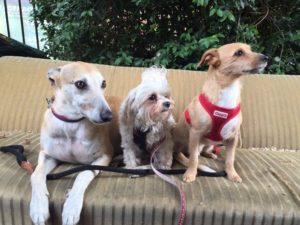
A brief history of breeding domestic dogs
Historically the breeding of domestic dogs has centred on the selection of certain behavioural characteristics in order for dogs to carry out certain roles such as hunting, herding, controlling vermin, or companionship. Typically, two dogs with similar characteristics, such as hunting, have been bred, and then the offspring with the strongest hunting characteristics are selected for further breeding, ultimately breeding a line of dogs with very strong behavioural traits. These have come to be known as ‘breed characteristics’. It is generally recognised among behavioural professionals that when a dog is deprived of the ability to perform the characteristics for which it has been bred, it can feel frustrated, and this is often a key cause of behavioural problems.
Breed characteristics
Breed characteristics refer to the various traits associated with different breeds of dog. These behavioural traits can include being good at herding livestock, hunting and guarding, chasing, or simply being a companion dog. While breed characteristics are general approximations of what behaviours a breed of dog may display, it is important to recognise that not all dogs of the same breed will display the characteristics of the breed profile, and dogs of the same breed can display big differences in behaviour. Importantly, breed characteristics can be influenced by training (or lack of) and the wider environment.
Why are breed characteristics important?
Understanding breed characteristics is very important when choosing a new dog. Owners should take into account the needs of the dog and their ability to accommodate these needs. For example, toy breeds are often not appropriate choices for families with young children, and working breeds, such as a German Pointer or a Border Collie may be better suited to rural environments. Some breeds, such as Staffordshire Bull Terriers, are good ‘city’ dogs, as are a number of ‘companion’ dogs.
Understanding breed characteristics is also important when rescuing, fostering, or re-homing a dog. A dog that has not lived with other dogs or cats before may be better suited to households where they are the only pet. Equally, dogs that have not been brought up around young children may be better homed in an all-adult household. Some rescue dogs may have greater needs than others and may therefore be better suited for adoption by ‘experienced’ dog owners.

Finally, understanding breed characteristics can help you understand how your dog may respond best to training. If your dog has a strong ‘chase drive’, your dog may find chasing balls highly rewarding. If your dog is driven by companionship and a close physical bond, rewarding them with touch and petting is highly appropriate. For most dogs, food and treats are strong reinforcers and can be used to great effect in changing unwanted behaviour.
While it is important to consider breed characteristics when choosing, re-homing, or training dogs, it should be borne in mind that these are general rules of thumb. For example, a dog that has not lived with children before can be taught to live happily in a family environment, and a dog that has been the only pet in the household can learn to happily co-exist with other pets. Well thought-out programmes of behaviour change, informed by a professional, can help to increase the chances of accommodating your dog’s needs, leading to a happy relationship between you and your dog.
This short blog was based on a technical report submitted to “Think Dog Advanced – breed characteristics”. The full technical report, with references, can be accessed by emailing the author at dannydecourtelle@rocketmail.com
